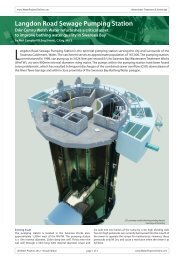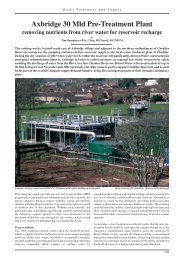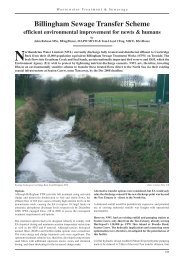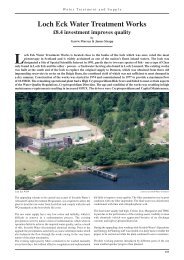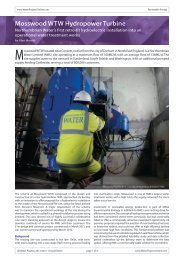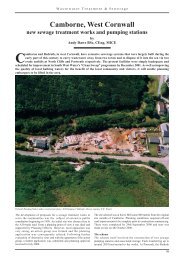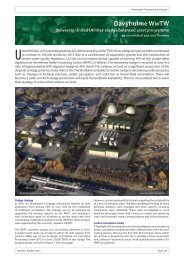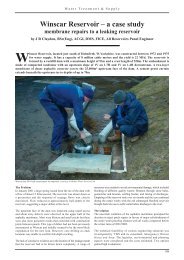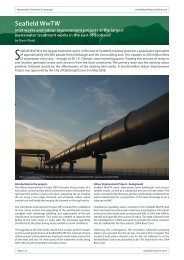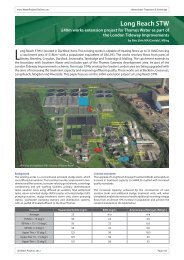United
Preston 32 UIDs - Water Projects Online
Preston 32 UIDs - Water Projects Online
- No tags were found...
You also want an ePaper? Increase the reach of your titles
YUMPU automatically turns print PDFs into web optimized ePapers that Google loves.
www.WaterProjectsOnline.com<br />
Wastewater Treatment & Sewerage<br />
The shaft was successfully constructed within 8.5m on plan of the<br />
adjacent low rise flats.<br />
The existing CSO and associated continuation sewer were situated<br />
in the centre of Ribbleton Lane, between a pair of 600mm diameter<br />
cast iron water mains operating at 10 bar, and below a number of<br />
other services. Upon investigation it was established that the cast<br />
iron water mains could not be diverted, or even be reduced in<br />
pressure, whilst the works were undertaken.<br />
To facilitate the connection to the existing sewer and the crossings<br />
of the water mains, a temporary works solution was developed.<br />
This was to clamp each joint of the water mains adjacent to the<br />
proposed connection MH and the existing CSO location with<br />
proprietary clamps. The clamped joint and pipe was then encased<br />
in reinforced concrete to act as a beam to span the open excavation.<br />
On completion of the works flexibility was restored to the water<br />
mains by core drilling the reinforced concrete beam at each joint<br />
location.<br />
Powis Road, Peddars Lane, Riversway and Watery Lane<br />
At these sites, engineers on the team identified that the provision<br />
of a tunnel solution, rather than the construction of large detention<br />
tank adjacent to the highway, would minimise stakeholder impact<br />
and associated health and safety issues. The tunnel solution also<br />
had the added benefit of providing the greatest operational<br />
protection against ‘tidal locking’ of the outfalls into the River Ribble.<br />
The tunnel solution collects spills from 4 (No.) existing UIDs and<br />
transfers flows into a storage tunnel connected to the Preston 7<br />
UID Tunnel (which is currently being constructed), providing both<br />
capital and operational cost savings when compared with the<br />
original standalone solutions.<br />
The tunnel solution was further rationalised by the deletion of an<br />
intermediate (drive) shaft following close liaison with the Preston<br />
7 UID team and utilisation of their (already constructed) shaft C4 as<br />
the drive shaft.<br />
The tunnel advanced at an average rate of production of 50m per<br />
week, based on two shifts working 5 days per week. The Sherwood<br />
Sandstone proved variable along the route and required the use of<br />
ground conditioning to dry the spoil in various locations.<br />
Conclusion<br />
The success of Preston 32 is as a result of collaborative working and<br />
the excellent working relationships developed between the <strong>United</strong><br />
Utilities design team, the construction partner and their detailed<br />
designers, <strong>United</strong> Utilities Operations and the many external<br />
stakeholders.<br />
The team overcame a number of significant challenges to identify<br />
suitable sites across the City of Preston, to develop innovative design<br />
and construction solutions for those sites whilst coordinating the<br />
delivery of the works, with Lancashire CC and the Preston Guild<br />
celebrations.<br />
The strength of the relationship has enabled the successful delivery<br />
of twenty-four of the twenty-eight UID schemes within 18 months,<br />
with many of the outputs delivered in advance of the regulatory<br />
date.<br />
At the time of writing (July 2013) the construction of the remaining<br />
4 (No.) outputs is nearing completion with the turning of the flows<br />
linked to the turning of the flows of the Preston 7 works, scheduled<br />
for completion in February 2014.<br />
The Editor & Publishers would like to thank the following for<br />
providing the above article for publication:<br />
John Littlewood, Design Manager with MWH for the Preston 32<br />
UIDs and the Preston 7 UID Tunnel, Will Taylor, Design Manager<br />
Penwortham Catchment with MWH, and Charlie Grealis, Area<br />
Construction Manager with KMI+.<br />
The tunnel was constructed using ‘Dorothy’, a Lovat Earth Pressure<br />
Balance Machine (EPBM) Tunnel Boring Machine (TBM). The TBM<br />
was launched from shaft C4 at an upgrade of 1:100 towards the<br />
reception Shaft 402. The tunnel is 750m long, comprising precast<br />
concrete rings of trapezoidal segments, 2.44m in diameter and<br />
approximately 26m below ground within the Sherwood Sandstone.<br />
The tunnel route passes close to the historic course of the River<br />
Ribble prior to it being realigned to accommodate construction of<br />
Preston Docks and crosses below a number of critical services and<br />
a busy dual carriageway.<br />
The tunnel portal from Shaft C4 to Shaft S402 was purposefully 2m<br />
higher than the adjacent Preston 7 UID tunnel portal. To launch<br />
the TBM from C4, the shaft was backfilled up to the invert level<br />
for the new drive, and an 8m long, 3m diameter launch tunnel<br />
was constructed. The TBM was assembled at the base of C4 and<br />
advanced into the launch tunnel with a jacking frame.<br />
The step in invert levels across shaft C4 initially prohibited the use of<br />
the Preston 7 UID tunnel as a back shunt to service the construction<br />
of the Preston 32 UID tunnel. Once the TBM and backup sledges<br />
were buried, the fill placed within C4 was re-profiled across the shaft<br />
to allow the support trains to negotiate the change in direction and<br />
gradient and travel to Shaft S4 (constructed as part of the Preston<br />
7 UID scheme).<br />
The Preston 32 UID tunnel was serviced from shaft S4, which<br />
allowed safe and efficient servicing with the support trains, along<br />
with maintaining all the existing traffic routes during construction<br />
of the tunnel.<br />
Watery Lane West - Tunnel Service Shaft S4<br />
Courtesy of KMI<br />
UK Water Projects 2013 Page 79



